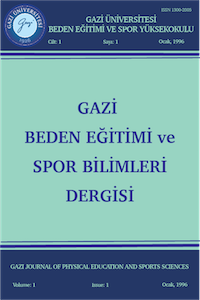Abstract
Bu araştırma kompleks cimnastik becerilerinin öğretiminde uygulanan
geleneksel öğretim yöntemleri ile ritm ile öğretim yöntemlerinin beceri öğrenimi
üzerine etkisini değerlendirmek amacıyla yapılmıştır. Bu amaçla, daha önce
cimnastik branşı ve müzikle ilgili deneyimleri olmayan, yaşları ons ekiz ile
yirmi altı (21,3± 2,1 yaş / yıl) arasında değişen 13’ü deney grubu (21,5 ± 2,3
yaş / yıl) ve 12’ si kontrol (21,0 ± 1,7 yaş / yıl) grubu olmak üzere toplam 25
erkek öğrenci araştırma kapsamına alınmıştır. Her iki gruba, sekiz haftalık
süre içerisinde, haftada üç gün ve günde bir buçuk saat olmak üzere bir ders
prog-ramı uygulamıştır. Grupların ders içerikleri aynı, ancak ders işleme
yöntemleri farklı olmuştur. Her iki grubun ön test ve son test ölçümleri arasında
gelişim farkı olup olmadığı parametrik olmayan Wilcoxon testi ile değerlendirilmiştir.
Grupların ön test ve son test ölçümlerinin karşılaştırılmasında parametrik
olmayan Mann-Whitney-U testi kullanılmıştır. Sonuç olarak, zorunlu seri
hareketleri ve seri ritmi teknik değerlendirme puanları arasındaki fark
incelendiğinde; deney grubunun ön ve son testler arasındaki puan farkında
p<0.001, kontrol grubunda ise p< 0,05 düzeyinde anlamlı bulunmuştur. Bu
sonuçlar, cimnastik branşında, ritm yeteneğinin ve ritmikleştirme becerisinin
geliştirilmesinin, hareketlerin doğru ve mükemmel teknikle sunumunda daha
etkili olabileceğini göstermiştir.
Keywords
References
- 1. Agopyan A.: Ritmik Sportif Cimnastikte Morfolojik ve Motorik Özelliklerin Performansa Etkileri. M. Ü. Sağlık Bilimleri Enstitüsü Y. Lisans Tezi, istanbul, s. 74-86, 1993.
- 2. Agopyan A.: Sportif Ritmik Cimnastikte Teknik Antrenman Yöntemlerinin Performansla ilişkisi. M. Ü. Sağlık Bilimleri Enstitüsü Doktora Tezi, istanbul, 2000.
- 3. Ansermet E.: Was ist "Rhythmik" Wolfenbuettel, 4, s.117-120, 1993.
- 4. Beitrag E., Dombrowski O.: Der Fon Macht die Music, s.14-17, Leichtathletiktraining, 1999.
- 5 .Beitrag E., Martin K., Ellermann U.: Rhythmische Schulung beim Lernen von Bewegung, s. 24-29, Leichtathletiktraining, 1999.
Abstract
The aim
of this study was to compare the effects of traditional education methods with
rhythm aided teaching methods used for the acquisition of complex gymnastic
skills, on motor characteristics and skill learning. For this purpose we
studied 25 male subjects, whose age ranged between 18 and 25 years (mean age
21,3 ± 2,1 years) and had no prior experience in gymnastics and music
education. We constituted a study (13 subjects, mean age 21,5 ± 2,3 years) and
a control group (12 subjects, mean age 21,0 ± 1,7 years). Both groups received
a standard education program (3 d/wk and 1.5 h/d) with identical content but
different teaching methodology. The intra-group development between the first
and second test was assessed with the non-parametric Wilcoxon test. The
inter-group differences between the first and second test was assessed with the
non-parametric Mann-Whitney-U test. The correlation of dependent and independent
variables were obtained by Pearson correlation. As a result, comparison of
differences in scores of the first and second test of obligatory movement
series technique and rhythm, revealed a significant increase both in the study
(p<0.001) and in the control group (p<0.05). This results show that
developing rhythm and rhythmization skills will improve movement technique and
accuracy in presentation.
References
- 1. Agopyan A.: Ritmik Sportif Cimnastikte Morfolojik ve Motorik Özelliklerin Performansa Etkileri. M. Ü. Sağlık Bilimleri Enstitüsü Y. Lisans Tezi, istanbul, s. 74-86, 1993.
- 2. Agopyan A.: Sportif Ritmik Cimnastikte Teknik Antrenman Yöntemlerinin Performansla ilişkisi. M. Ü. Sağlık Bilimleri Enstitüsü Doktora Tezi, istanbul, 2000.
- 3. Ansermet E.: Was ist "Rhythmik" Wolfenbuettel, 4, s.117-120, 1993.
- 4. Beitrag E., Dombrowski O.: Der Fon Macht die Music, s.14-17, Leichtathletiktraining, 1999.
- 5 .Beitrag E., Martin K., Ellermann U.: Rhythmische Schulung beim Lernen von Bewegung, s. 24-29, Leichtathletiktraining, 1999.
Details
| Subjects | Sports Medicine |
|---|---|
| Journal Section | Articles |
| Authors | |
| Publication Date | April 1, 2005 |
| Submission Date | June 2, 2005 |
| Acceptance Date | August 15, 2005 |
| Published in Issue | Year 2005 Volume: 10 Issue: 2 |
Gazi Journal of Physical Education and Sports Sciences is a scientific and peer-reviewed journal published quarterly.


